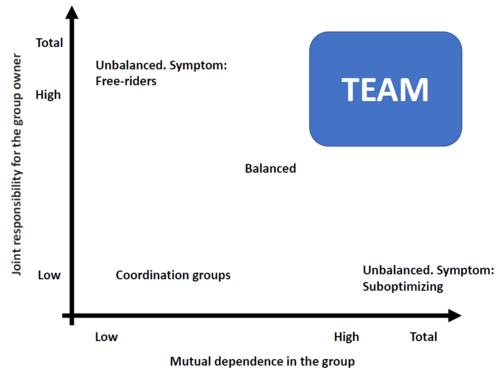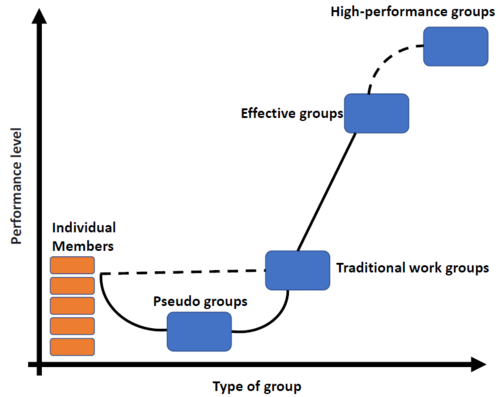High performing teams
Developed by Tobias Hyldmo. Exchange student from Industrial Economics and Technology Management at the Norwegian University of Science and Technology.
Contents |
Abstract
This article is about high performing teams. At first the article describe differ-ent types of teams and we outline what differs them from each another. Pseudogroups, traditional work groups, effective groups and high performance groups areintroduced. This article especially outlines the difference between the last two.Johnson & Johnson (2013) describes seven guidelines for effective teams. An effectivegroup utilizes all the advantages by working together and perform better than themembers would have done individually. High performing teams follow all theseguidelines. A high performing team is characterized by the high level of commitmenteach team member have to each other and to the success of the group.Not manyteams reaches this level, as it requires a bigger effort from the team members thatwhat can usually be expected (Johnson & Johnson, 2013).In the end, the guidelines are put in a practical setting and the article look on howthese tools can help us get benefits in both a short and a long term relationship witha team. They are also compared to existing standards described described in Maylor(2010) and put into a context of managing people from the course curriculum. Inthe end the article critically reflects on how theory about groups not always fit thereal world and we discuss whether some of the guidelines are more appropriate thanothers. Guideline six is highlighted as we discuss the important, and dangerous,role of conflicts in teams compared with theory of teams in Wheelan (2016) and aproject management setting in Maylor (2010). Conflicts can give the group energyand direction if it is handled in a good way, but can be destructive if the team isnot fit to handle the conflict or if it is interpersonal.
Big idea
In this part of the article we will quickly present the difference between groups andteams from Hjertø (2013), different types of groups and the seven guidelines foreffective teams from Johnson & Johnson (2013) and briefly discuss them.
Application
In this part of the article we will see how theory about efficient teamwork fits a realworld setting.
Limitations
In this part of the article we will have a look at situation where theory does notfit real world settings and critically reflect on a couple of the guidelines. Here thearticle will compere how these guidelines fit with the standards described in thecurriculum of this course.
Annotated bibliography
In Johnson & Johnson (2013) you can read a deeper explanation of the seven guide-lines for efficient teams, why they are there and dangers that may occur if the groupis not able to handle incorporate them.Maylor (2010) describes the role of leadership and management in projects. Thisgives a nice edge to this article as it puts it in a practical context.Wheelan (2016) is about effective teamwork from the persons perspective. There isvery much focus in today’s world about effective leadership and management, butthis source focuses more on how we as individuals can behave to support a highperforming team.TODO: In this part I need to extend the explanation to around 100 words perreference, and add references from the course curriculum and PMI standards.
Bibliography
Hjertø, K. B. (2013).TEAM. Fagbokforlaget, first edition.
Johnson, D. & Johnson, F. (2013).Joining Together. Group Theory and GroupSkills. Pearson, twelfth edition.
Maylor, H. (2010).Project Management. Prentice Hall, fourth edition.
Wheelan, S. A. (2016).Creating Effective Teams. A Guide for Members and Leaders.SAGE, fifth edition.

